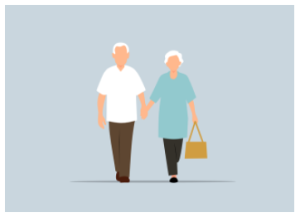Population Aging – The Numbers
 According to the CDC, the average life expectancy of an American born today is ~78 years. However, in 2024 ~101,000 Americans reached the age of 100 (Pew Research Center). Not only that, but statistical methodologies project that this number is expected to slowly increase – at least over the next few decades (IHME, 2024).
According to the CDC, the average life expectancy of an American born today is ~78 years. However, in 2024 ~101,000 Americans reached the age of 100 (Pew Research Center). Not only that, but statistical methodologies project that this number is expected to slowly increase – at least over the next few decades (IHME, 2024).
What’s up with that?
What are these centenarians doing that separates them from the rest of us?
Starting back in the early 2000s, Researchers set out to look for answers to this question.
Their investigation – which is still ongoing – became known as …

The Study was first launched by a small team of Researchers working in collaboration with the National Geographic Magazine.
Their hypothesis was that the answers to this “How come they live so much longer?” question could be found by examining lifestyle behaviors and environmental factors.
The initial Research group began a worldwide search to find isolated communities with the highest life expectancy – or with the highest proportions of people who reached100 years of age.

By 2005 they had found five locations that met these two criteria.
- Barbagia, Sardinia: An island with the world’s highest concentration of male centenarians.
- Ikaria, Greece: An island with one of the world’s lowest rates of middle age mortality and dementia.
- Nicoya Peninsula, Costa Rica: An area with the lowest rates of middle age mortality, and second highest concentration of male centenarians.
- Seventh Day Adventists, Loma Linda CA: Members of this community live 10 years longer than their North American counterparts.
- Okinawa, Japan: An island with the longest lived females in the world.
Once these locations were identified, investigative teams were assembled consisting not only of medical researchers but also anthropologists, epidemiologists, and demographers.
Although the Research teams did not actually live in these communities, they spent significant amounts of time immersed in the local cultures and environments. They interviewed residents, observing and gathering data on their lifestyles, including diet, habits, social connections, and traditions.
Research methodologies were then designed to analyze findings and look for any evidence-based common denominators.
What they found was that, as well as being long lived, the people living in these small, relatively isolated communities retained remarkably high levels of health and vitality—well into their 80s 90s and 100s. They also did not typically suffer from the common degenerative diseases found in other parts of the industrialized world.
Interestingly – and in supportive of the initial hypothesis – even though these locations were thousands of miles apart, Researchers found a number of commonalities in the lifestyle behaviors of these otherwise disparate peoples.

Nine commonalities were identified, and they became known as …
Here’s a summary of each POWER. Check out the link above for more detail
Power 1. Move Naturally
Residents rarely, if ever, “Worked out”. They lived in environments that constantly nudged them into moving without thinking about it. Things like gardening, household chores, manual work, and walking featured prominently in their lives.
Power 2. Purpose
Residents had a sense of purpose – knowing why they woke each morning. Researchers found that this was associated with up to seven years of extra life expectancy.
Power 3. Downshift
Residents had natural, built-in methods of relieving stress. This varied between communities but included taking a few moments each day to remember their ancestors, praying, taking a nap or even have happy hour.
Power 4. 80% Rule
Residents generally ate only until they were no more than 80% full. Researchers suggested that the 20% gap could be the difference between losing or gaining weight. They also ate their smallest – and last – meal in the late afternoon or early evening.
Power 5. Plant Slant
Residents’ diet consisted mainly of vegetables and legumes (beans, lentils, etc). Meat was eaten in small (palm sized) servings, only about once per month.
Power 6. Wine @ 5
Residents of all communities (except Adventists) drank alcohol moderately – mainly wine ~1-2 glasses per day – typically with friends or family and/or with food.
Power 7. Belong
Residents mostly belonged to some kind of faith-based community. Denomination didn’t seem to matter. Researchers found that attending faith-based services four times per month added 4-14 years of life expectancy. No data on whether it was the faith/religion per se, or the sense of belonging/fellowship these meetings elicited.
Power 8. Loved Ones First
Residents put family first. They kept aging parents/grandparents nearby or in the home, committed to a life partner, and invested time and love in their children.
Power 9. Positive Pack
Residents chose – or were born into – social circles (“Packs”) that supported healthy behaviors. Researchers found that the social networks of long-lived people favorably shaped their health behaviors.

FUTURE FORWARD – THE BLUE ZONES PROJECTS
Blue Zones Project took the learnings from the ongoing Blue Zones Research and started working with populations/neighborhoods in North America to establish “Blue Zones Communities”
In 2009 a successful pilot project was launched in Albert Lea, Minnesota.
Since that pilot program, the Blue Zones Project has expanded to 51 communities across the USA.
According to the Blue Zones website…
“Our work has produced double-digit drops in obesity, smoking, and body mass index, among other health and well-being improvements.”

Take Home Message
- To make it to age 100 you have to be a winner in the genetic lottery.
- However, most of us have the capacity to make it well into our early 90s – largely without chronic disease.
- The Blue Zones approach to Lifestyle and the Power 9 principles can be – and has been adapted to US communities
- The average person’s life expectancy could increase by as much as 10-12 years if they (and their community) adopt a Blue Zones lifestyle.
For more information on the POWER9 , and all things BLUE ZONES check out “The Blue Zones Story”
NOTE: If you are interested in obtaining more information on Blue Zones or if you feel that Research could Matter to some aspect of your business or lifestyle…
Email Dr. Phillips directly at wphillips@syfound.com – or use our Contact Page
